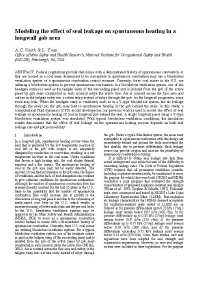Mining Publication: Modeling the Effect of Seal Leakage on Spontaneous Heating in a Longwall Gob Area
Original creation date: June 2010
Federal regulations provide that mines with a demonstrated history of spontaneous combustion or that are located in a coal seam determined to be susceptible to spontaneous combustion may use a bleederless ventilation system as a spontaneous combustion control measure. Currently, three coal mines in the U.S. are utilizing a bleederless system to prevent spontaneous combustion. In a bleederless ventilation system, one of the headgate entries is used as the tailgate entry of the succeeding panel and is isolated from the gob of the active panel by gob seals constructed in each crosscut inby the active face. Air is coursed across the face area and outby in the tailgate entry into a return entry instead of inby through the gob. As the longwall progresses, some seals may leak. When the headgate entry is ventilated, such as in a Y-type bleederless system, the air leakage through the seals into the gob may lead to spontaneous heating in the gob behind the seals. In this study, a computational fluid dynamics (CFD) model developed in our previous work is used to model the effect of seal leakage on spontaneous heating of coal in longwall gob behind the seal. A single longwall panel using a Y-type bleederless ventilation system was simulated. With typical bleederless ventilation conditions, the simulation results demonstrate that the effect of seal leakage on the spontaneous heating process depends on both seal leakage rate and gob permeability.
Authors: AC Smith, L Yuan
Conference Paper - June 2010
NIOSHTIC2 Number: 20037506
Proceedings of the 13th U.S./North American Mine Ventilation Symposium, Sudbury, Ontario, Canada, June 13-16, 2010. Hardcastle S, McKinnon DL, eds., Sudbury, Ontario, Canada: MIRARCO - Mining Innovation, 2010; :479-484
See Also
- Determining the Source of Longwall Gob Gas: Lower Kittanning Coalbed, Cambria County, PA
- Effects of Ventilation and Gob Characteristics on Spontaneous Heating in Longwall Gob Areas
- Evaluating Ventilation Parameters of Three Coal Mine Gobs
- Investigation of Longwall Face Ventilation Air-Splitting Methods for Improved Dust Control
- Modeling the Effect of Barometric Pressure Changes on Spontaneous Heating in Bleederless Longwall Panels
- Prediction of Porosity and Permeability of Caved Zone in Longwall Gobs
- Simulation of Spontaneous Heating in Longwall Gob Area with a Bleederless Ventilation System
- Strengthening Existing 20-psi Mine Ventilation Seals With Carbon Fiber-Reinforced Polymer Reinforcement
- A Study of Leakage Rates Through Mine Seals in Underground Coal Mines
- Use of Vertical Boreholes for Assisting Ventilation of Longwall Gob Areas
- Page last reviewed: 9/21/2012
- Page last updated: 9/21/2012
- Content source: National Institute for Occupational Safety and Health, Mining Program


 ShareCompartir
ShareCompartir
